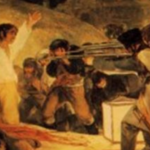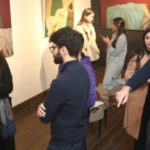1. Please tell us about your current solo show’s body of work. What is the concept behind the theme?
I am a multidisciplinary artist, curator, and educator. My practice is rooted in traditions of abstraction, where I engage gestural and poetic approaches to address autobiography, trauma, and sexuality. The title of my latest solo exhibition, We Are Not Our Desire, is borrowed from Be Your Own, a poem by Peter Scalpello. The show brings together a new body of oil-based enamel and watercolor paintings exploring queer intimacies, encounters, and desires. My images feature expansive chromatic planes of relative spatial flatness that ground face-less portraits and bodies that mesh through moments, memories, and imaginings to speak as constructions and dreamscapes of queer personal and political storytelling.

2. What mediums have you worked with in this show?
I use various media to create my paintings, including household enamel paints, watercolors, and acrylic inks.

3. What is your favorite medium to work with?
Fluidity, spontaneity, and immediacy are central to my painting and creative process. I often work with industrial oil-based enamel paints that allow me to combine representational forms with bold abstract movements, such as drips and splashes, dragged paint, and large gestural brush strokes. In contrast to the opacity and stickiness of the gloss paint, which results in layers of plastic-like skins and deep textures, I also like working with translucent watercolors and acrylic inks that delicately weave overlapping shapes and forms.

4. You work extensively on queer experiences of men. How do they adapt for a country like Pakistan? Do you feel that these experiences are the same around the world?
A crucial component of art practice is considering and responding to your context and environment. The bulk of the conversations on queerness, including queer theory and representation, are dominated by Western perspectives and positionalities. Yet, as Bell Hooks described it, queerness is not just about sex but a political stance that is at odds with everything unjust around you. In this sense, queerness as a radical act of resistance to the hegemonic structures of patriarchy, capitalism, and colonialism is not confined to the West but has existed throughout time, everywhere. For example, the portrayal of non-heteronormative desire and expression is present at various points in South Asian history, including in Urdu literature and poetry. By focusing on presenting my experiences of navigating queerness as a racialized person alongside representations of other queer men in Pakistan and elsewhere, I intend to expand larger discourses on queer artistic practices and complicate discussions on non-heteronormative gender, sexuality, and masculinities.

5. What is next for Abdullah Qureshi?
I am currently working on my doctoral project at Aalto University in Finland. My dissertation, Mythological Migrations: Imagining Queer Muslim Utopias, examines formations of queer identity, resistance, and community in Muslim migratory contexts through contemporary art practice. My investigation emerges from an urgent need to critically interrogate and expand queer Muslim immigrant perspectives in response to the rising Islamophobia, racism, anti-immigrant sentiments, homophobia, and transphobia in the West over the last two decades. Simultaneously, the project seeks to challenge the widely held belief that Islam and liberal conversations on gender and sexuality are inherently contradictory to open and expand the contextualization of queer Muslim migratory identities. Building upon critical transnational feminist and queer intersectional scholarship, I argue that the multitude of issues of exclusion, rejection, and fetishization experienced by queer Muslim immigrant bodies is not isolated but a direct result of orientalist and colonial hegemonic global structures. My project includes two artistic components, Chapter 1: The Nightclub (2019) and Chapter 2: The Darkroom (2020), and a monograph I plan to complete in 2025.

6. Any advice for aspiring artists?
Keep doing your work, be fearless in your explorations and experimentations, question and criticize art institutes and influential spaces, and counter them by creating your critical communities and networks of support.







